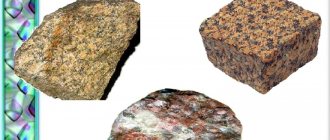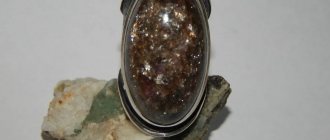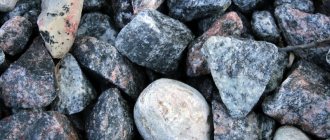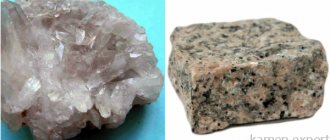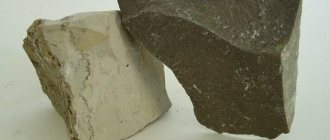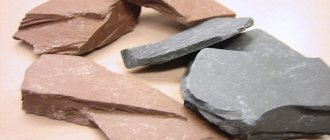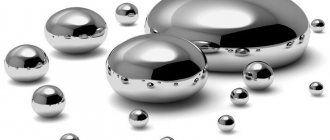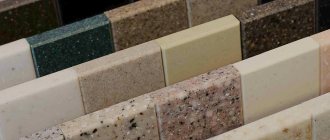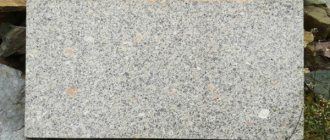Granite is widely used in modern life. Its physical properties, structure, composition make the mineral in demand in production and construction. Stone is a natural and therefore environmentally friendly material. It has radioactivity, but minerals with low emissivity are selected for use in everyday life.
Granite is known for its rich range of colors, which are given to it by structural elements - chemical substances included in the composition. It is varied in texture and looks harmonious with other materials - wood, brick or marble. Granite masses were used to construct significant buildings. Today the stone is more common.
What is granite
The word "granite" comes from Latin and means "grain". The material is an igneous plutonic rock. It consists of large grains, the maximum size of which reaches 1 cm. This exceeds the granularity parameters of marble. In geology, stone is considered the hallmark of the earth's crust, since it is one of the main components of the composition of the upper layer of the planet's surface and mountains. Although it is believed that there is granite on Venus.
The unique natural and physical properties of stone make it indispensable in many branches of human activity. The main advantage of the mineral is strength. It resists chemical and physical influences for centuries. Granite is not affected by microorganisms, especially mold or mildew. This explains its long service life.
Granite is valued for its waterproofness, wear resistance - resistance to abrasion and scratches, as well as immunity to temperature changes. The mineral has high design qualities. It is valuable in landscape design, interior and exterior.
The great mystery: why do the minerals in granite have exactly this ratio?
Another amazing fact that baffles almost all geologists and chemists can amaze anyone. After all, if you follow the generally accepted theory of melting of solid crustal matter, when low-potassium granite material is formed, which makes up only 20% of the total mass, 80% of the solid residue should remain, in which there is no water. These must be minerals: pyroxene, the same plagioclase or garnet. But during research such layers were not found!
What lies hidden in the depths of the earth’s crust with huge layers of granite rock can only be guessed at. One thing is undeniable: the composition of granite is truly unique, although scientists have not yet been able to find similar rocks on other planets.
Origin of granite
The formation of granite is a question that has given rise to many theories. Scientists of the 18th century claimed that granite arises from crystals that settle to the bottom of the sea. A century later, a theory appeared that the stone was a clot of magma, which, when raised to the earth's surface, baked other materials. They cool along with the magma and crystallize. In the last century, it was believed that granite is formed as a result of washing rocks by underground water. Under the influence of water movement, some crystals are washed away, while others are transformed into crystals.
The last two theories are now considered correct. Experimental studies show that granite is formed in two ways:
- granitization - the transformation of minerals into crystals under the influence of groundwater;
- magmatically - as a result of volcanic eruptions.
Where are granite deposits located?
The main place where granite occurs is the batholith mountain ranges, the length of which is about 4 km and the area of several hectares. Sometimes during mining it is clear that several layers of stone have been formed: granite and its sedimentary rock. The stone itself appears in the form of wide layers, alternating with representatives of sedimentary and metamorphic species.
Like other minerals, which are not very rare, granite has become widespread almost everywhere: it can be found on any continent . Due to the fact that over millions of years, ancient rocks gradually displaced younger formations to the top, it came to the surface and became available for mining. Read more about where granite is mined →
Properties of granite
Here are the characteristics of the mineral:
| Hardness | 6-7 units on the Mohs scale |
| Density | 3.17 g/cm3 |
| Ultimate compressive strength in dry and wet conditions | Respectively 604 kg/cm2 and 550 kg/cm2 |
| Water absorption | 0,2% |
| Melting temperature | +700 0С |
| Thermal conductivity | 3.49 W/(mK) |
| Radioactivity | 0.05 μZ/h |
Granite mass parameter is 2500-2700 kg/m3.
The level of moisture absorption determines the hardness of the mineral: the lower the percentage of water absorption, the more durable the mineral is. The low moisture absorption is explained by the deep occurrence of the rock in the subsoil.
The mineral composition of granite affects its structure. There are such structural varieties:
- fine-grained;
- medium grain;
- coarse stone.
The parameter of a mineral with small grains is 2 mm. This breed is more valued than others in various industries. The stone has a high resistance to mechanical stress, and its melting point is higher than usual.
Although granite has high strength and density, it lends itself well to cutting, grinding and other processing methods. The mineral is carefully cut; after processing, an almost glossy sheen appears on the surface, which is equal to marble.
The chemical composition of granite is dominated by alkalis. There is also magnesium and iron. The basis of the mineral is:
- Silica – 72%.
- Alumina – 14.4%.
- Magnesia.
- Titanium dioxide.
- Iron minium.
- Potassium oxide.
- Sodium oxide.
- Calcium oxide.
The last three elements account for a total of 9%.
Classification of granitoids by grain structure
The size and structure of grains differ from one another to different types of stone.
Based on this, granite comes in the following types:
- if the grain size does not exceed 2 mm - fine-grained ;
- grain size up to 5 mm - medium-grained ;
- coarse-grained appearance - more than 5 mm.
A fine-grained stone will have the highest level of resistance to mechanical damage. It is characterized by more uniform abrasion over time, resistance to winds and high temperatures. The fine-grained fraction is always the most expensive. It practically does not absorb water and is highly resistant to fire.
When building houses, coarse-grained granite is often used. It is cheaper, so after fires you can often see granite stairs that have cracked and are no longer usable.
Types of granite
Depending on the proportion of dark-colored minerals in the composition, granite can be as follows:
- Plagiogranite is a light gray plagioclase material.
- Hornblende is a mineral with a high content of hornblende.
- Hornblende-biotite is a stone with a high content of hornblende and biotite.
- Alaskite is a granite made from biotite and potassium-sodium feldspar.
Hornblende plagiogranite
Hornblende-biotite granite
Depending on the texture and structure of the mineral, they are distinguished:
- porphyritic – a rock composed of microcline, quartz and orthoclase. The dimensions of these elements reach 10-15 cm;
- Rapakivi is a stone whose name means “rotten”. It is a variation of the previous mineral with a high content of pink feldspar grains. They are joined by light green plagioclase. Rapakivi is round in shape. The mineral tends to crumble.
Porphyritic
Rapakivi
Stone processing
The stone is very durable. You can split granite stone with a hammer, cleaver, or sledgehammer. You can break the stone into two parts, split it into several large parts, knock off some parts (shards) or trim it, giving it the desired shape, creating edges - smooth surfaces (faceted granite).
During processing, diamond drills are used for cutting and grinding. It is easy to give the source the desired shape using a tesque. Sometimes heat treatment is required. Heat-treated granite has a rough surface. Bush hammered granite also has such a surface. The essence of the treatment is the shock-rotational effect of special sprockets made of hard alloys.
On the map, the symbol for granite is crosses (pluses) in a frame.
Also watch the program about processing:
Granite color
The color is influenced by the composition, especially the proportions of chemical elements - potassium spar, iron oxide and others. The main component that determines the color of the stone is feldspar - plagioclase, orthoclase, microcline. The priority color of the mineral is gray, which is formed from plagioclase. Inclusions of dark tones are added to it. Happens:
- green;
- red - a stone with a predominance of potassium spar, which contains a lot of iron oxide;
- yellow;
- brown;
- pink;
- black and white - formed by a compound of quartz, amphibole or spar;
- white is a name for yellowish or light gray rocks. Pure white granite does not exist in nature. Shades of yellow come from milky white quartz, and light gray from similarly colored feldspar.
Thanks to quartz, which appears as grains of 2-25 mm of transparent color, similar to glass, granite shimmers from certain viewing angles. Rarely found is bluish granite, which gets its hue from quartz.
Geochemical classification of the White and Chappell granitoids
For the convenience of designating one or another type of granite stone, in the mid-70s of the last century, a brief analysis of granitoids was made based on their most common types.
In this analysis, four types of stone were identified - S, I, M, A:
- Sedimentary (S) - the stone is the result of the melting of metasedimentary rocks;
- Igneous (I) - a product of melting metamagma substrates;
- Mantle (M) is a stone formed from magmas, which include tholeiitic and basaltic rocks.
The chemical composition of granite S is close to granitoids I in most elements, with the differences being that S stones contain little calcium and sodium. Later in the classification, a type A type of granite , differing in composition from subalkaline stones and consisting of a large number of incoherent chemical elements.
Use of granite
The physical properties, especially the high strength of granite, and the wide distribution of stone in nature make it a popular material in manufacturing, construction, landscape and interior design. Let us indicate the areas of use that use granite processing:
- Chemical industry - due to resistance to salts and acids.
- Construction: cladding of swimming pools, embankments, fountains, external decoration of buildings - due to the low percentage of water absorption and frost resistance, respectively.
- Repair: interior decoration - due to low abrasion coefficient.
- Road construction - due to low abrasion and high strength.
They also create from granite:
- Elements of a street road: curbs, paving stones.
- Architectural forms: monuments, columns, parapets, stair steps.
- Elements of interior decor and finishing: wall and floor tiles, countertops, window sills, cornices, vases.
- Production parts: elements of factory machines and high-precision measuring instruments, millstones.
- Railway embankments.
Areas of application
Durable rock has been used in architecture since ancient times. Not all people know that the Egyptian pyramids were built using granite. Many structures were built in Ancient Rome and India. The stone, which is characterized by durability, can withstand any climatic conditions. He is not afraid of either wind or rain.
Today, granite is used to make not only various buildings, but also stairs, steps, curbs, and street tiles. The mineral is used in the construction of monuments, sculptures, vases, columns, bridges, benches, artificial reservoirs and other architectural objects. Natural material is often used to create countertops.
The excellent performance characteristics of granite allow it to be used not only for external, but also for internal work. It is used for cladding walls and floors in a house or apartment. Any product made from a reliable building material is easy to use. No complex maintenance is required to maintain the finish in its original form.
When people decide to choose granite for finishing their home, they often doubt the choice of the appropriate stone option. Among the large variety of species, it is difficult to determine which material is considered the best. The choice of mineral depends on the purpose of its use. It should be mentioned that liquid granite, which can replace cement, is a new prospect in construction.
The stone looks harmonious in combination with marble. Items with a combination of these materials look attractive and majestic. And sometimes white granite can replace marble, which it is very similar to after proper processing. Since stone is more durable than marble, during use it does not lose its original shade, structure, or texture. Granite has only one drawback: it has the greatest weight among building materials, which must be taken into account when constructing bridges, monolithic houses and other large structures.
Interesting facts about granite
Although the stone is weathering, architectural, religious and other structures, objects and products that have high cultural value have survived to this day. Here are some architectural monuments of antiquity:
- Escorial is a monastery in Spain.
- Stonehenge is an English monument to the culture of ancient peoples. The total mass of its stones is 50 tons. It is surprising that this structure is man-made.
- The Temple of Hatshepsut is a sanctuary in honor of the ruler of Ancient Egypt, the total weight of which is 343 tons.
- Pedestal for the statue of the Bronze Horseman weighing 2,000 tons.
- Alexandria Column - originally it was a rough stone 30 meters high.
Escorial
Stonehenge
Temple of Hatshepsut
Alexandria Column
Granite was actively used in the construction of St. Petersburg, especially such buildings:
- Saint Isaac's Cathedral;
- Admiralty;
- Stock Exchange;
- Academy of Arts.
Popular message topics
- City of Tula
The Vyatichi lived on the territory of the present city. There was a small settlement here. Which did not stand out among other similar settlements. The town belonged to the Ryazan principality, and in the 16th century it passed to the Moscow principality. Because of, - Plants of the Krasnodar region
In the southwestern part of Russia there is a wonderful region. Its name is Krasnodar region. There is a special nature here with its flora and fauna. Thanks to its temperate climate, the territory of the Krasnodar Territory is characterized by warm - Cabbage butterfly
The cabbage butterfly can be found in Asia, North Africa and Europe. Most of all, she chooses habitats in meadows, forest edges and clearings. Large concentrations of cabbage weeds can be observed near railways and country roads.
